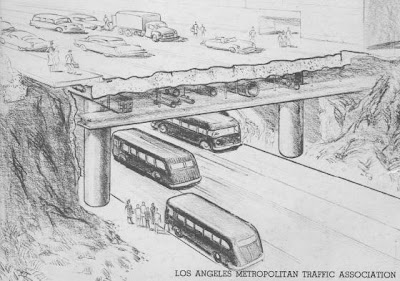 Contemporary street scene with 1953 image of soldier in Piccadilly Circus
Contemporary street scene with 1953 image of soldier in Piccadilly CircusIn addition to transit and transportation news and research, we are also periodically highlighting innovations in libraries and archives which will shape the way we search for and find information in the future. New technologies are disseminated, adopted and embraced more quickly than ever, so we may see projects and ideas like this coming our way soon.
The Museum Of London has launched an iPhone application which brings its extensive art and photographic collections alive in advance of the opening of spectacular new galleries next week.
The free app, called "StreetMuseum," takes users to various sites in London where, via their iPhone screen, historical images of the city appear. Over 200 sites have been selected where users can look through their iPhones and see the past emerge.
While the historic images can be enjoyed by themselves, the real magic combines information from the image along with the location of the user. Geotagging metadata in the images and GPS technology in the phone are mashed up to overlay the user's location with historic information about the same place.
Here's how it works. The iPhone user opens the app and it determines the phone's location. A map then opens showing the users position and locations of the various sites where they can view historic images of London:
 London 3-D view locations
London 3-D view locations
When you touch one of the tags, a small window opens which describes the location, date, and creator of the image. One click of the blue arrow on the right of that window allows the image appear and be enlarged. English suffragette Emmeline Pankhurst restrained by police outside Buckingham Palace, ca. 1908
English suffragette Emmeline Pankhurst restrained by police outside Buckingham Palace, ca. 1908
If the user is in the location pictured, they can click on a "3D view" button which allows the app to recognize the location and overlay the historic image onto the current view, augmenting the reality that the built-in iPhone camera perceives. Bomb destroys Bank Tube station, 1941
Bomb destroys Bank Tube station, 1941
One can imagine that the appeal of this technology would not be limited to either this particular museum or London.
The veritable explosion of applications for iPhones and other smartphones means that we can expect to see historic images coming alive "in situ."
It is also worth noting that by the year 2020, mobile devices will be the primary connection tool to the internet for most Americans. Painting of skaters on the frozen Thames River, 1677
Painting of skaters on the frozen Thames River, 1677
Forward-thinking museums, libraries, archives, and universities will embrace placing interactive tools in the hands (literally) of everyone from history buffs to tourists walking through an unfamiliar city. Imagine what this would look like for Los Angeles. Our city is large, diverse and decentralized with a compelling history. It isn't the easiest place to learn about or navigate if one is not familiar with its layout or terrain. Salvation Army Headquarters, Queen Victoria Street, May 10, 1941
Salvation Army Headquarters, Queen Victoria Street, May 10, 1941
Now imagine if a network of institutions such as L.A. As Subject (of which we are a member institution) pooled their visual resources to make a project such as this a reality.
Students, researchers, historians, tourists and others would be guided to and through our unique historic and cultural heritage, allowing everyone access to the stories and events that have made Los Angeles the subject of study for people throughout the region and around the world.
Until then, or at least until you bring your iPhone to London for real-time interactivity, you might enjoy Flickr's "Looking Into The Past" photo set (example below). Easter Egg Roll at US Capitol, 1924, via Flickr
Easter Egg Roll at US Capitol, 1924, via Flickr
.jpg)








